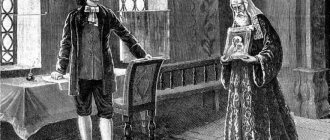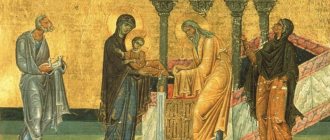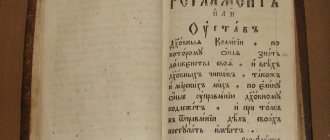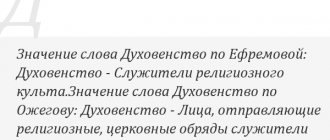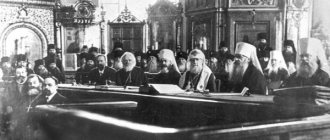In the first years of his reign, Ivan the Terrible carried out a number of reforms that covered all aspects of the life of the state: military, legal, tax and others. The church reform of Ivan the Terrible is not as famous as all the others. However, it became the first reform of the church of the Russian kingdom during the tsarist period. The next one was held only more than 100 years later, under Tsar Alexei Mikhailovich and Patriarch Nikon.
Background and procedure
The reasons for the church reform were the same as for other reforms. As centralization progressed, the Russian kingdom required unification of various spheres of life. One of them was the church one, so it is not surprising that the reform followed immediately after the convening of the first Zemsky Sobor.
Rice. 1. Tsar Ivan IV.
The reform was carried out by the Stoglavy Council, which operated in Moscow from February to May 1551. The venue was the Assumption Cathedral. The Stoglavy Cathedral was a combination of church and zemstvo cathedrals. It was attended by:
- Ivan IV.
- Representatives of the Boyar Duma.
- Higher clergy. Metropolitan Macarius (chairman), Archpriest Sylvester (compiled the text of the agenda), archbishops of all dioceses (Tver, Smolensk, Ryazan, Perm, Rostov, Krutitsk, Suzdal, Novgorod, Kolomna).
The decisions of the cathedral were formalized in 100 chapters, which is why it received the name “Stoglav”.
The Council rejected Ivan IV's plans for the secularization of church lands, but, on the other hand, the increase in church properties in cities was limited. The holding of the cathedral is connected with the controversy between two movements in the Orthodox Church - the Josephites and the non-possessors. The latter opposed church land ownership and were partly reminiscent of Protestants in Europe in the 16th century.
Rice. 2. Metropolitan Macarius 1551.
First period (before 1589).
No matter how respected the decrees of the Byzantine emperors on church affairs were among our newly enlightened ancestors, they could not replace local Russian church legislation, due to their low applicability to the local conditions of Russian life. Meanwhile, the introduction of Christianity in Russia was necessary to provoke the Russian government into legislative activity on church affairs, since it gave rise to a number of completely new legal relations that the Russian pagan state did not know. In the same way, the Russian clergy was a completely new class in Russian society, for which it was necessary to create a special position characteristic of it among other classes of society. It was finally necessary to provide material resources to the newly established church union. All these urgent needs of the newly enlightened Russian society, necessarily associated with the introduction of Christianity, attracted the attention of the first Russian princes, enlightened by Christian teaching, and were satisfied through legislation. Evidence of this is the church charters of Vladimir (996–1014) and Yaroslav (1051–1054) that have come down to us with the name of the first Russian princes.
Charter of Prince Vladimir
came to us in many lists of various editions. I usually distinguish two editions - short and lengthy, and Metropolitan Macarius also recognizes the middle one. In addition, there are also lists of the charter, in which the decrees are set out not on behalf of the prince, but in the form of a historical story under the title: about church people, and about courts, and about tithes, and about city measures. The main difference between different editions of the charter lies in the prefaces and afterwords, the order in which the material is presented, and in some particulars. In essential content they are all similar to each other. The senior list of Vladimir's charter was preserved in the Novgorod Kormcha of the end of the 13th century; it concludes the complete version of the charter.
According to the subjects of content, Vladimir’s charter is divided into four parts.
The first part defines the princely salary of the cathedral church, called tithe. This tithe was to be separated from all court duties of the prince, from trade duties, and from all tributes received by the prince's treasury. In some lists containing editions of the charter under the title “Rule on church people and on tithes and on episcopal courts” (Right. Sob. 1861. vol. II. p. 435. Compare Makar. Tser. Ist. vol. 1 p. 269) Vladimir learns the granting of the right to cathedral churches to acquire real estate.
The second part defines the authority of the ecclesiastical court in relation to all Christians. The Church Court was provided with the following. violations of church discipline: 1) adherence to pagan beliefs and customs (praying under a barn, in a grove or by the water; sorcery, various kinds of witchcraft, divination, preparation and use of various kinds of magical means, 2) sacrilege, grave robbery, insulting holiness and inviolability the temple and all places and things belonging to it, 3) crimes against purity of morals, 4) marriage cases, namely cases of divorce, illegal marriages of close kinship and affinity, due to violence, 5) family feuds, quarrels, fights, litigation between husbands and wife about property, litigation between brothers or children about inheritance.
The third part lists church people and almshouses; these include: persons of the monastic and white clergy - a message with wives and children, a prosphora maker, a blind man, a lame man, a wanderer, a wanderer (a slave freed in the church during the life of the master), a soulless man (freed according to a spiritual will), homeless widows and orphans , in general, all the orphans, the poor, the crippled and homeless, who lived near the church and fed on the funds of the church. It is remarkable that among the church people there is also a healer - a doctor. This is, of course, because in the churches there lived people who could provide medical assistance in order to wean newly initiated pagans from their custom of turning to healers and sorcerers. These people are left to be judged by the church authorities in all matters, not only ecclesiastical, but also secular, namely in civil litigation, in cases of fight, murder, and disputes over inheritance. If church people have a lawsuit with people of the secular department, then the court should be common.
In the fourth part of Vladimir's charter, the church authorities were given control over the accuracy of weights and measures and the right to levy fees for this. In ancient times, auctions were held at churches, in church squares. Measures and scales were kept at the churches. From here arose naturally the right of the clergy to manage weights and measures.
It is impossible to think that the monument known under the name of the church charter of Prince Vladimir in the form in which it has come down to us was the work of the pen of Prince Vladimir. This cannot be expected, first of all, in view of the state of legislation in which it was in the primitive era of our Russian history. The main source of law at that time was custom. The entire life of the Russian people during the princely period was determined by custom. The orders of the princes were only an addition to the original custom. And they were given initially verbally, without being expressed in writing. With the spread of literacy, they began to be written down, but only for memory; That's why they got the name charters. (Sergeevich Lectures and research on the ancient history of Russian law. St. Petersburg, 1894, p. 520). Then, the absence of a specific, precisely established text of the monument in the wide variety of its editions and presentations, as well as obvious anachronisms in some of them, speaks against the authenticity of the presentation of the charter of Prince Vladimir. There is no need to talk about the authenticity of the lengthy edition of the charter, since it admits an obvious anachronism in the preface when it is said that Prince Vladimir received baptism from the Patriarch of Constantinople Photius, who died 80 years earlier. And the brief version of Vladimir’s charter also suffers from some ambiguities in the presentation, for example. regarding church tithes, or allows details that are not very applicable to the time of Vladimir, for example. when to talk about hospitals, hotels, hospices. Therefore, the Code of the Charter of Prince Vladimir should be considered a later record of the orders of Prince Vladimir, made partly on the basis of chronicles about Prince Vladimir and his time, and partly on the basis of existing practice. This order of origin of the presentation of the charter of Prince Vladimir is suggested, for example, by the special edition of the charter of Prince Vladimir, entitled “on church people and on courts and on tithes and on city measures,” where in the form of an anonymous historical record it is reported what was done in the benefit of the church by the first Russian Christian princes in general. And this form of recording was in use at the end of the 13th century; According to this entry, one of the Vladimir bishops makes a reference to the charter of Russian princes to the son of Alexander Nevsky (Prov. Sob. 1861. vol. III. pp. 467–472).
If not a single copy of Prince Vladimir’s charter, or even a single edition of its presentation, can be considered a copy of Prince Vladimir’s original order on church affairs, then how can one find out what Prince Vladimir’s charter should have consisted of, judging by the surviving records about him. The researchers answer as follows: “What they (editions of the charter) all agree on, what constitutes their common basis, can undoubtedly be considered to have belonged to the original charter of St. Vladimir" (Makariy. History of the Russian Church. Vol. 1. p. 129. Golubinsky. History of the Russian Church. Vol. 1. First half of the volume. Edition 2. p. 400. Nevolin. About the space of the Church of the Court. Collected Works, vol. 6, p. 295). This measure is certainly correct. But it does not need to be applied mechanically. Its mechanical application does not give a proper understanding of the essence and historical foundations of the legalization of Prince Vladimir in church affairs, nor will it understand the historical and everyday significance of the features of different editions and lists of the charter of Prince Vladimir. The practical change in the norms contained in the charter of Prince Vladimir did not stand motionless at one point, but was subject to gradual development and change. According to prof. Golubinsky, at the beginning “the matter was established only in principle - what can and cannot belong to the realm of the church court, but the details, more or less defined boundaries of this court were established only by time and custom” (p. 410). This historical movement in the practice of applying the norms of the charter of Prince Vladimir, naturally, should have been expressed in experiments in the written presentation of this charter. Hence, some features of different editions and lists of the Vladimir charter can be understood as traces of this historical process. From this point of view, the true meaning of the various features of different editions and lists of Vladimir’s charter will be determined, and the true basis of Prince Vladimir’s decrees on church affairs will also become clear.
In the lengthy edition of the charter of Prince Vladimir, all four of these parts are united by a preface, which informs about Vladimir’s acceptance of Christianity from Patriarch Photius, and an afterword, which contains a threat of God’s wrath and curse for violating all the orders of the prince set out in the charter. This rhetorical dressing of the orders of Prince Vladimir is a later addition to the content of the charter; the extreme and middle editions do not have it. The preface is compiled on the basis of the Novgorod chronicle, which says at the beginning that Prince Vladimir received the first Metropolitan Leon from Patriarch Photius. And it is remarkable that the senior copy of the Rule of Vladimir with such a preface is found in the Novgorod Kormcha 1280, written under the Novgorod Archbishop Clement. But even in the lengthy edition of Vladimir’s charter, despite its artificial rhetorical dressing, there remained traces of the fact that Prince Vladimir’s charter, as presented in the lengthy and short editions, was not a complete law, published at the same time, but constitutes a record of decrees issued at different times time, at known intervals. All statements of the Vladimir charter say that the law on the space of the church court was issued a certain time after the decree on tithes. The same can be said about the regulations regarding church people and the observation of centuries and measures.
The granting of tithes from princely income to the cathedral churches, which constitutes the first part of Vladimir's charter, undoubtedly belongs to Prince Vladimir himself. This is supported by the fact that Vladimir built the Tithe Church of the Virgin Mary in Kyiv and endowed it with tithes from the princely income. This fact was followed by a general decree on the donation of tithes from the princely income to any newly established cathedral church. Such a resolution is directly indicated by the charter of the Novgorod prince Svyatoslav Olegovich in 1137; “The charter that was before us in Rus' from our great-grandfathers and from our grandfathers was to give tithes to the scribes from tribute and from vir and from sales that are included in the prince’s court of everything.” This is also evidenced by historical examples of the actual application by the princes of the said great-grandfather’s charter, for example. a charter of 1150 from Prince Rostislav Mstislavich given to the Smolensk bishopric during its establishment. In the presentation of the charter of Prince Vladimir, this legalization of Vladimir is described in a confusing manner. It appears as if Prince Vladimir gave tithes only to the Kyiv Church of the Most Holy. Mother of God and, moreover, “in all the Russian land in all cities.” This is the text of a brief version of the charter of Prince Vladimir. He almost literally repeats the words of the chronicle under 1169: “he gave tithes to that church throughout the Russian land.” The presentation in the lengthy version of the charter for the senior list is somewhat better, but still very dark and unsatisfactory. In the edition of the charter entitled “The Rule of Church People and Tithes” (in Solovetskaya Kormcha 1493. No. 858 l. 540–543), the story of tithes is presented abstractly, without reference to the construction of the Kiev Tithe Church, and the establishment of tithes is brought into connection with the law God given to the Israelites and adopted by pious Christian kings (Right. Sob. 1861. vol. 3. pp. 434–435); here Vladimir’s law on tithes is also left in the shadows. Thus, none of the editions of the presentation of the charter of Prince Vladimir provides clear and accurate information about the publication by Prince Vladimir of the law on tithes to the cathedral churches. Of course, this does not speak in favor of the authenticity of the records that have reached us about the contents of the mentioned law. But this same phenomenon clearly proves that from the shortcomings in the presentation of the charter of Prince Vladimir it is still impossible to draw a negative conclusion regarding the existence of this law.
According to the words of the charter of Prince Vladimir, the prince assigned tithes to the cathedral churches “from his property and from his cities,” that is, from his private economy and from state revenues. The sources of state princely income were tributes, viras (fines for criminal offenses) and sales (fees from civil court cases). It is also very likely that Prince Vladimir donated for the maintenance of cathedral churches and real estate (Golubinsky. Ist. Russian tser. vol. 1. part I. pp. 510–511).
Tithes from private princely estates were given to bishops in kind - bread, livestock and other agricultural products. Ten court fines were forwarded to the bishops at the end of the year. Since doubts and misunderstandings often arose about the amount of this tithe, sometimes the princes agreed in advance with the bishops on the amount of the annual tithe and paid according to this condition, as the Novgorod prince Svyatoslav Olegovich did in 1137. The tithe from the tribute assigned to the bishops was separated into a special tax, which was left to the bishops themselves to collect from the population. In the 12th century in the dioceses that were reopened, the tithe of the cathedral church was given only with tribute, as can be seen from the charter of Smolensk Prince Svyatoslav Olegovich in 1137. After the Mongol invasion, the issuance of tithes was completely stopped (Golubinsky, pp. 514–515).
The question of the subjects of the church court, which constitute the content of the second part of the charter of Prince Vladimir, had a close connection with the tithe of princely income from the proceedings of the court. This issue should have been resolved immediately after the church hierarchy assumed its rights as the organizer of church order among the newly enlightened people. According to the natural order of things, such crimes should have come under the jurisdiction of the church court that constituted violations of the new norms of life introduced with the adoption of Christianity. And since the rules of Christian discipline concern various aspects of life, especially deeply affecting marriage and family relations, then, naturally, among the offenses brought before the church court, there should have been quite a few that relate to civil and criminal relations. The secular authorities had to submit these cases to the jurisdiction of the church court because the very norms, violations of which were dealt with by the church court, were based on the laws contained in the Helmsman and little known to the secular authorities. With this understanding of the origin of the department of the church court in relation to all members of the church, it is natural to think that the department of the church court in general principles should have been determined from the very beginning of the establishment of church orders in Russia. Only a few details and particulars could be clarified due to the circumstances of the time and as the church court came into force and subordinated the behavior of church members. This circumstance of the gradual penetration of the principles of Christian discipline into the life of the newly enlightened people can explain the comparative brevity or completeness in the listing of subjects of the department of the church court in various editions of the presentation of the charter of Prince Vladimir
When the requirements of church discipline gradually took root in the life of Russian society, they had to be protected by both the secular law with its instructions and the secular court with its punishments, especially when the violated norms had social significance. Of course, the church authorities, which always wanted to go hand in hand with the secular authorities in their activities, could not look unfavorably on the repressive measures of the secular authorities against violations of the rules of church discipline. From the canonical answers of Metropolitan John II it is clear that the church authorities transferred unrepentant sorcerers into the hands of secular justice. (answer 7). One of the earliest examples of secular punishments for religious crimes is represented by serious criminal penalties for sorcery. Secular courts and punishments for crimes of a religious nature did not eliminate church courts and the actions of church authorities. According to the chronicle, not only secular, but also church authorities took part in events against wizards (Nevolin. Sochin. vol. VI. pp. 290. 350). This should also be evidenced by the fact that cases of fortune telling and magic in all their forms are among the subjects of church court in all editions and lists of the charter of Prince Vladimir until later times. Another example of the joint action of secular and church authorities against violations of the rules of church discipline, accepted as norms in civil society, is represented by the court in cases of abduction of girls for marriage or simple cohabitation. In the statutory charter of the Smolensk prince Rostislav Mstislavich, the case of the abduction of a girl is named among the subjects of the church court, but at the same time, regarding the judicial fine for this offense, it is prescribed to divide it by gender between the prince and the bishop, and the prince is placed in the foreground (what the prince will pay, with the bishop on the floors), which means he is the initiator of punishment.
There is also a case of collision between the ecclesiastical and secular courts, namely in inheritance cases. Due to the close connection of these affairs with family affairs, which were generally administered by church authorities, these matters, naturally, should have been subject to the jurisdiction of church authorities. And they really are among the subjects of the church court in all editions of the presentation of the charter of Prince Vladimir. But in the Russian Pravda (Karamz. sp. art. 117) matters regarding the division of inheritance are listed as the responsibility of the prince. This place of Russian Truth is cited as evidence of the non-authenticity of the charter of Prince Vladimir. Meanwhile, in fact, the very evidence of the Russian Truth requires explanation and verification, in view of the agreement of all editions and all lists of the charter of Prince Vladimir until later times regarding the belonging of inheritance cases to the jurisdiction of the church court, and also in view of the fact that the later In practice (until the end of the 17th century), this issue was resolved in favor of the church court. (Compare Nev. Sochin. vol. VI. p. 275. note 70. Sergeevich. Lectures. p. 32).
The resolution of Prince Vladimir's charter on the department of the church court in relation to the clergy does not require explanation. Clergy are removed from the jurisdiction of the secular court and are subordinated to the jurisdiction of the church court in all cases, not only church, but also secular, due to the primitive structure of judicial procedures in the secular department. The courts are also subject to the same order. church people following the example of the clergy, on the basis of class. It is in vain that they reproach the presentation of Vladimir’s charter for the fact that it already mentions charitable institutions - monasteries, hospitals, hotels, hospices, which could not have existed under Prince Vladimir. These institutions were already in their infancy under Vladimir (Nevolin. Sochin. vol. VI. p. 326). But even if we omit these expressions, the essence of the matter will not change; they are not needed, strictly speaking, since the abbots, monks and almshouses are listed above as being under the jurisdiction of the church.
They doubt whether the church authorities had the right to supervise city weights and measures. But there is nothing surprising in granting such a right to the clergy; it was made following the example of Byzantine practice, where bishops participated in the selection of weighers and weights and measures were kept in churches under the supervision of bishops. Perhaps the charter of Prince Vladimir, elevating the right of bishops to observe weights and measures to the institutions of God himself, also had in mind the legislation of Moses (Lev.19:35–37. Deut.25:14–16. Nevolin. Works. vol. VI . page 284). On the vital significance of the resolution in question in the charter of the book. Vladimir, one can find evidence in other monuments, for example. in the charter of the Novgorod prince Vsevolod Mstislavich of 1134–1135, in which the Church of John the Baptist on Opoki was given the right to hold scales and weigh known goods on them, also in the agreements of the Smolensk prince Mstislav Davidovich with German cities, where it was stated that the verification of scales, which goods were weighed should have been done using standard scales kept in the church of St. Our Lady on the Mountain and in the German Church. Subsequently, the supervision of weights and measures became the responsibility of secular authorities (Nevolin. Sochin. vol. VI. p. 324).
Thus, despite the variety of editions of the presentation of the charter of Prince Vladimir, despite the many variants of the text of its different lists, its main content can be dated back to the time of Prince Vladimir and therefore we can rightly say with Professor Vladimirsky-Budanov that this charter “depicts for us the true the relationship of the church to the state, which the church considered then (during the zemstvo period) to be normal” (Anthology on Historical Russian Law. Ed. 5. p. 232. Compare Pavlova, Course of Church Law. 1903. p. 136).
Results and significance of church reform
It's best to group them into different topics in a table:
| Financial | Religious | Household |
|
|
|
The 101st chapter on church land ownership was subsequently added to the 100 chapters of the church sentence.
Rice. 3. Stoglav 1551.
